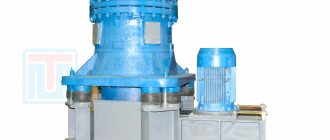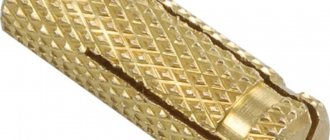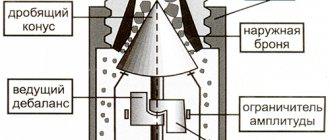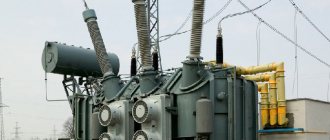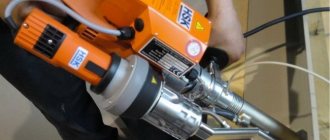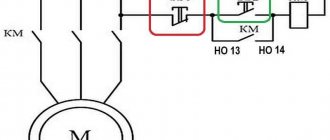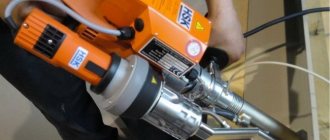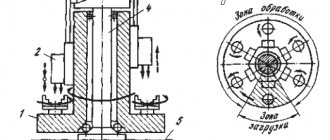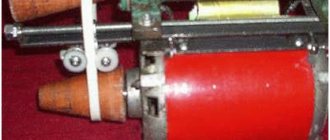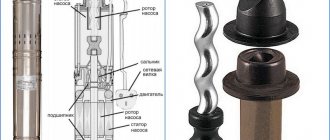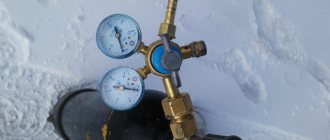Requirements for jaw crushers
Construction . It must be such as to ensure round-the-clock operation, including stops for routine inspection and maintenance, as well as safe access to places of adjustment, lubrication and replacement of wearing parts. In addition, the following must be provided:
- protection against breakage when an indestructible element enters the chamber;
- protection of lubricated friction pairs from dust;
- no upper ejection of pieces from the crushing chamber;
- both local and remote control.
Materials . The “cheeks” are the most subject to wear, so they are made of wear-resistant alloys. The type of metal is selected in accordance with the rock being crushed. For crushing hard materials, “cheeks” made of steel alloyed with chromium or manganese are used; for soft materials, “cheeks” are made of half-bleached cast iron.
Pros and cons of jaw crushers
Advantages . These include the following:
- high wear resistance of working elements (“cheeks”);
- small dimensions for easy transportation and installation;
- accuracy of output size adjustment;
- stable operation under intensive round-the-clock load;
- simple maintenance and easy replacement of worn parts.
Flaws . They are related to the design and operation features of crushers, and are as follows:
- impossibility of use for working with elastic materials - wood, plastics, some alloys;
- significant vibrations, requiring a very solid foundation and not allowing installation on upper floors;
- unsuitability for working with flagstone rocks (easily divided into plates).
Crushers with a simple movement of the movable jaw (SMJ).
The crusher with a simple movement of the movable jaw is installed on a frame, in the side walls of which the main bearings of the eccentric shaft are fixed. A connecting rod is suspended from the eccentric part of the shaft. At the bottom of the connecting rod there are grooves for installing the support blocks of the spacer plates. When the eccentric shaft rotates, the connecting rod receives a rocking motion, which is transmitted to the movable cheek using spacer plates. The cheek receives a pendulum movement centered on the suspension axis. Fixed and movable crushing plates are fixed on the cheeks.
The width of the exit slot is adjusted by installing additional spacers of varying thickness between the stop and the rear wall of the frame, a system of wedges on screws, or replacing the rear spacer plate with a longer or shorter one.
The advantages of crushers with a simple swing of the jaw are: the ability to crush high-strength rocks and relatively little wear of the crushing plates. The disadvantage is the high metal consumption compared to crushers with complex jaw swing, as well as the greater unevenness of the resulting fraction.
Types of jaw crushers
The main parameter for the classification of equipment is the nature of the movement of the main working body - the “cheek”. It defines the most important technical and operational characteristics of jaw crushers and divides them into two groups.
With simple movement (SHDP) . The “cheek” moves along a circular arc. Shredding of lump material is carried out by crushing. The advantages of such models include less wear of crushing surfaces and the ability to work with high-strength rocks. The disadvantages are higher metal consumption and unevenness of the final material compared to the second group of crushers.
With complex movement (SCDS) . The movable cheek moves along a closed curved path, most often along an ellipse. The equipment crushes the material by both crushing and abrasion. Such crushers have more compact dimensions and are used to work with relatively small ores with a low content of abrasive substances and a high content of moisture and clay. They are not used for coarse crushing.
How to make a crusher with your own hands
Having basic knowledge of physics, it is quite possible to make a crusher with your own hands. As a rule, a low-power electric motor , usually no more than 1 kW.
There is a technique that helps to design a mechanism with the necessary characteristics. First, you need to decide on the material to be processed.
- In order not to complicate the design, it is better to make a mechanism with one movable cheek . For a fixed cheek, a cast iron sheet is suitable, which is installed at an angle on a solid base. The slope is required to create an upper hole for filling the material. Also, by changing the angle of inclination, you can adjust the crushing gap.
- metal shaft as a movable cheek . It is driven by an electric motor through a belt drive, which is needed to reduce the number of revolutions and increase the load characteristics of the engine. In case of overload, the belt drive will avoid jamming.
- The rotation of the shaft should be directed towards the product filling.
- The crushing parameters change when the lower attachment point of the fixed cheek is shifted.
- The entire mechanism can be placed in one housing, and a hopper can be made on top for loading.
For household use, as a rule, crushers made from improvised materials are used. At its core, it is a container with a shaft mounted on bearings and several knives. The shaft rotates thanks to an electric motor through a belt drive. To regulate the speed of rotation of the shaft, wheels of different diameters are installed.
A common use of such mechanisms in the household is chopping vegetables , herbs, etc. They can also be used in construction, for making gravel or crushed stone.
Widely Used Coal Crusher
As a well-known crushing equipment manufacturer, SBM offers you high quality coal crushers with low price. Widely used crushers for crushing coal are jaw crusher, impact crusher, cone crusher and roller crusher.
Jaw Crusher for Coal Crushing
Coal jaw crusher, also known as coal jaw crusher, performs the crushing process by moving two jaws. Coal jaw crusher is widely used in many fields, such as mining, metallurgy, building materials, highway, railway, water conservation, chemical and so on. A jaw-type coal crusher allows crushing all types of materials with a compressive strength of no more than 320 MPa. As one of the most common crushing equipment, the jaw crusher appears earlier than other crushing machines. Jaw crushers are commonly used as primary crushers, and are one of the main types of coarse crushers in a mine or concentrator. Our stone crusher is designed based on many years of product development. Our jaw crusher is divided into 11 models, which can meet most productivity requirements in primary and secondary crushing, with low energy consumption and easy maintenance. Every feature of these primary crushers has been carefully designed to ensure superior quality and performance, which is why our jaw crushers have already won first place in the Chinese and overseas markets.
Impact Crusher for Coal Crushing
Impact crusher for coal crushing is a new type of high-efficiency coal crusher, characterized by small size, simple structure, high crushing ratio (up to 40), low energy consumption, high productivity and good particle distribution. All these advantages make the impact crusher your crushing equipment in coal mining technology. The impact crusher is used in processing plants due to the use of highly abrasive materials for the production of spare parts. Besides crushing coal, the impact crusher can process mineral and quarry materials with a length ranging from 100mm to 500mm, with the highest compressive strength can reach 350MPa. When it comes to mineral impact crusher, there are so many manufacturers in the world, so it is difficult to choose a great manufacturer. In China, SBM enjoys good reputation at home and abroad, and our coal impact crusher is very popular among customers for open pit coal mining. We believe SBM will be your good choice.
Cone Crusher for Coal Crushing
Coal crushing cone crusher is a widely used crushing plant for processing hard coal, also used for medium crushing and fine crushing of all kinds of rocks and minerals with pressure below 350Mpa into small sizes in coal, mining, cement, sand and other fields . The ideal combination of high-performance crushing chamber and high crushing frequency greatly improves the controllability of the cone crusher. Working principle of cone crusher: When the cone crusher is running, the motor rotates around a fixed point through the belt wheel or clutch, while the transmission shaft and cone part of the cone crusher are adopted by the action of the eccentric bushing, which makes the crushing wall close to the punched mortar wall at regular intervals time. The coals will then be subjected to pressure, pressure and constant bending in the crushing chamber, resulting in the coal being crushed. All spare parts for the cone crusher are made of high-strength materials.
Roller Crusher for Coal Crushing
A roller crusher for crushing coal can be called a compression crusher. In the mining industry, roller crushers are used to crush ores and medium- to low-hard rocks, for the production of cement, chemicals and construction materials. Its effect is higher than that of conventional crushing equipment. The roll crushers used can be divided into 2 types: single roll crusher and double roll crusher. The advantage of a roller crusher for crushing coal is that it produces a final product that has a fine size distribution, and they produce little dust or fine particles during operation. Roller crusher is widely used for crushing low abrasive minerals and small-scale mine production. Roller crushers are mainly used in coal mining. When mining coal, the surface of the rolls will have teeth or convex shapes (when used for mineral and metal ores, the rolls have a smooth surface). SBM can provide you not only with the coal crushing roller crusher and all accessories, but also with introduction to type selection, installation guide, etc.
Technical characteristics of roller crushers
The double-roll crusher can be installed not only indoors, but also in an open area under a canopy. It is possible to install a two-roll crusher directly in front of the conveyor belt on supports, platforms and foundations.
Double-roll crushers are a very economical device; their use consumes a small amount of electricity. In addition, the two-roll crusher is reliable in use - the mechanism of one of the rolls does not allow uncrushed particles to pass inside.
Features of twin-roll crushers.
Two-roll crushers are most widely used in industry. To avoid jamming and breakage from the entry of too large or uncrushable pieces of rock, one of the rolls, a two-roll crusher, is installed in a moving bearing.
Basically, in modern designs of two-roll crushers, the drive of each roll is carried out from an individual electric motor (sometimes several), less often from one through a gearbox and cardan shafts.
Let's take a closer look at the design of a two-roll gear crusher, using a coal crusher as an example. This two-roll crusher consists of a housing or frame on which two working shafts with replaceable crushing rolls mounted on them are mounted in roller bearings.
For access to the rolls and their dismantling, the crusher body is made detachable, consisting of lower and upper parts. In the side parts of the crusher body there are inspection hatches for access to the working parts of the crusher. In the upper part of the crusher body there is a place for securing the loading bell. The connector locations of the crusher housing are sealed with rubber gaskets.
The crusher body is equipped with coils into which coolant is supplied to heat the crusher during the cold season in order to avoid freezing of the material on the walls of the body.
There are two rolls, each with a diameter of 1100 mm and a length of 1000 mm. The rolls used are smooth, cast from manganese steel, corrugated (toothed) or one is corrugated and the other is smooth. By installing grooved rolls, larger pieces of material can be fed into the crusher. The rollers are located horizontally and rotate towards each other at different frequencies (170-200 rpm).
The size of the output slot of a two-roll crusher is regulated by the displacement of the work rolls and is regulated by the movement of the bearings of one of the rolls. Their position is fixed on one side by spacers, and on the other is supported by powerful springs with adjustable tension. Springs protect roller crusher units from deformation, making it possible to increase the distance between the rollers and allow uncrushable objects to pass through.
The material is fed into the loading zone of the crusher from above, crushed and removed down through the discharge openings.
The rollers of a two-roll crusher can have individual drives from electric motors. A V-belt drive is used to transmit torque from the electric motor to the rollers. On less powerful modifications, drive from one electric motor is possible. In this case, rotation is transmitted to the first work roll through a pair of gears, and to the second roll it is transmitted from the first through a second pair of gears mounted on the work shafts. To prevent damage to the roller crusher mechanisms when an uncrushable object hits, the crusher drive is equipped with safety devices.
To drive the rollers, two three-phase squirrel-cage electric motors with a power of 30 kW are used, which are powered by an alternating current network (380V; 50Hz). The electric drive of the crusher is controlled remotely, the starting electrical equipment is mounted on a separate panel.
Design
Despite the variety of design features, most jaw crushers use designs that were developed more than a hundred years ago.
The main regulatory document relevant for this equipment is the interstate standard that is still in force, adopted in 1993 - GOST 27412-93. The standard jaw crusher model includes the following main components:
- Bed . It is a cast base on which all other parts and mechanisms are installed. The frame has a reinforced design and significant weight, since the safety of the crusher depends on its stability and reliability.
- Crushing chamber. It is formed by two crushing plates (cheeks) and has a wedge shape. One of the surfaces is fixedly fixed, the second is placed on the connecting rod and together with it carries out a reciprocating (swinging) movement in the vertical direction. The movable “cheek” is designed so that it is possible to adjust the position of its lower edge in the horizontal plane and set the maximum size of crushed pieces at the exit.
- Eccentric shaft . Transfers energy from the power drive to the movable “cheek” and converts rotational motion into reciprocating motion. The main shaft contains a connecting rod, a pulley and a flywheel.
- Drive unit . It includes an electric motor and a drive pulley connected to it through a coupling, which is fixed to the shaft and transmits torque to the driven one.
- Control system . Ensures the execution of all basic commands: step start, emergency shutdown, activation of protective relays (during overload, overheating, etc.), operation of a pre-start alarm, and more.
